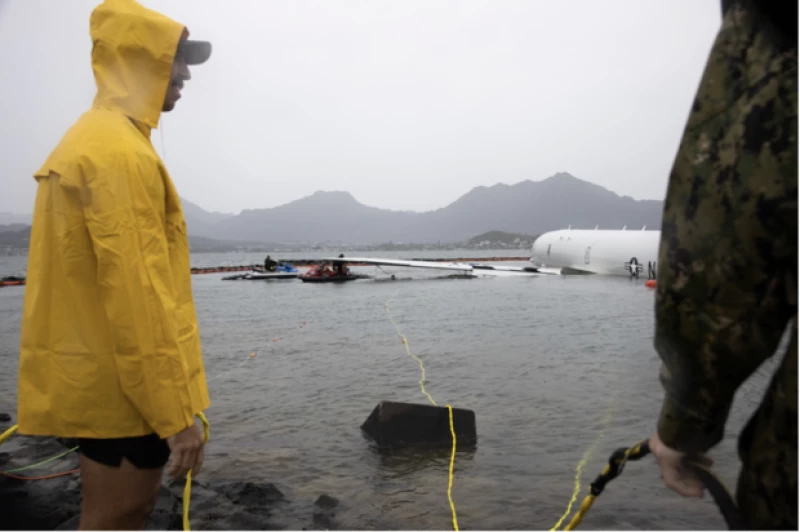Navy Plans to Remove Surveillance Plane from Hawaii Coral Reef
The U.S. Navy has unveiled a $1.5 million plan to remove a surveillance plane that overshot a runway at a military base in Hawaii and ended up in Kaneohe Bay. The bay, known for its coral reefs and as a breeding ground for hammerhead sharks, is also home to a University of Hawaii marine biology research institute.
According to a Navy spokesperson, the salvage operation is estimated to cost around $1.5 million, with approximately $200,000 already spent as of December 1. The spokesperson added that more accurate figures will be available once the salvage operation is complete. The Navy's primary focus is to safely recover the aircraft while protecting the environment and ensuring the aircraft's combat capability is retained.
Rear Adm. Kevin Lenox, the commander of Carrier Strike Group 3 and leader of the salvage effort, has expressed confidence that the operation can be carried out without causing further damage to the coral reef. The Navy plans to use inflatable cylinders to lift and roll the jet plane off the reef before removing it from the ocean waters where it crashed on November 20.
An incident occurred at Marine Corps Base Hawaii when a P-8A aircraft overshot the runway and crashed into an environmentally sensitive bay, located approximately 10 miles from Honolulu. Fortunately, none of the nine individuals on board were injured. The Navy is currently conducting an investigation into the mishap.
Underwater footage released by the Navy reveals the landing gear wheels resting on crushed coral, while the majority of the plane remains afloat above the reef in Kaneohe Bay.
To mitigate any potential environmental damage, a team from the Navy has already removed nearly all of the estimated 2,000 gallons of fuel from the aircraft.
The process of removing the plane from the bay is expected to commence on Saturday, according to Lenox. However, he refrained from providing a specific timeline for the completion of the operation, as weather conditions and other factors could impact the schedule.
On Friday, contractors began using inflatable bags to slide under the plane. Once inflated, the bags will float across the water towards the runway. Upon reaching land, machines will pull and roll the bags onto and across the runway.

Lenox stated that there is a possibility that one of the bags may come into contact with a small section of coral, although this is not guaranteed.
He further explained that the force of the plane will be evenly distributed across the entire surface area of the bags, resulting in only 3 to 5 pounds (1.3 to 2.3 kilograms) of pressure on any given point where they make contact with the ground. This pressure is significantly less than that exerted by a person standing on the ground.
"We are highly confident that we can successfully complete this entire operation without causing any further harm to the local ecosystem," stated Lenox.
Once the plane is removed, officials from the state of Hawaii will assess the reef for any damage.
Kaneohe Bay is known for its diverse marine life, including coral reefs, sharks, octopus, and various fish species. The area is also home to an ancient Hawaiian fishpond that is currently being restored by community organizations.
In 2015, contractors were able to remove a 1,000-ton barge from a delicate seagrass habitat in the Outer Banks of North Carolina after Hurricane Florence. Lenox mentioned that the plane, weighing about 60 tons, is significantly lighter than the barge.
The Navy initially considered floating the jet within range of a crane on the runway and then lifting it onto land. However, Lenox explained that the inflatable cylinder method was deemed safer and was expected to have minimal impact on the coral and the aircraft itself.
The plane is currently in good condition, and the Navy is hopeful that it can be restored and put back into service, according to Lenox.
The military utilizes the P-8A, which is a modified version of the 737 jet, for submarine detection, surveillance, and reconnaissance missions.
A Boeing-made plane has been assigned to Patrol Squadron 4, which is stationed at Whidbey Island in Washington state. In order to take over the squadron's patrol missions near Hawaii, a separate crew from Whidbey Island has been deployed to Hawaii.







